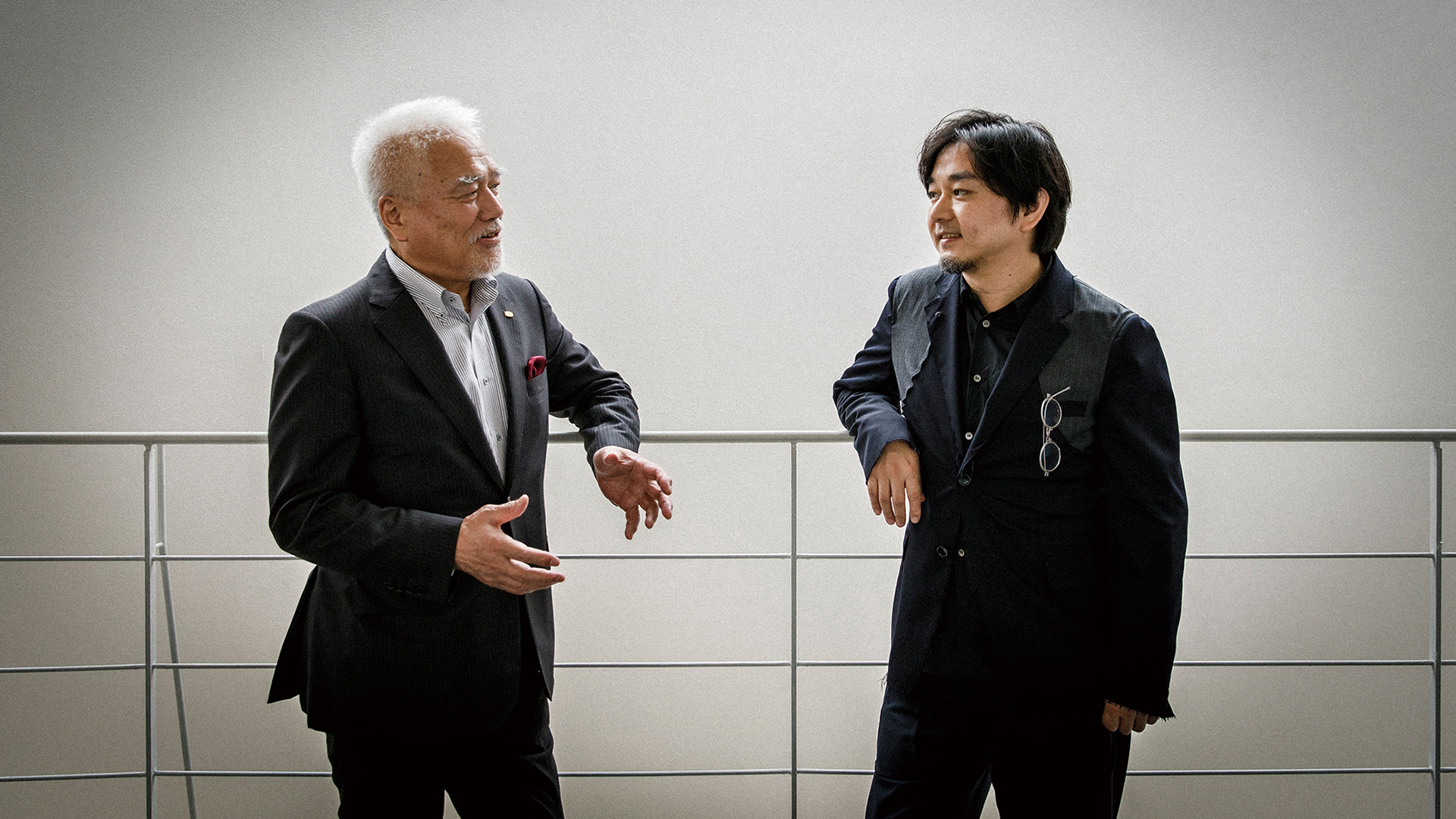
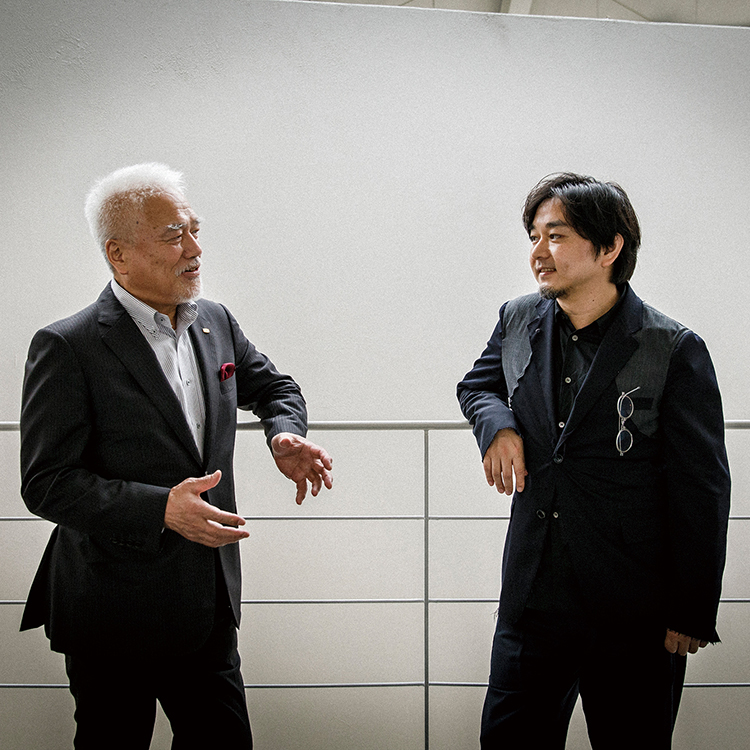


Junzo Tateno
CEO of UNION Corporation
Born in 1947, Junzo Tateno graduated from the Faculty of Law at Konan University (Kobe, Japan) in 1970
and entered Aoki Construction that same year. He joined UNION in 1973 and became CEO and President in 1990.
He serves as Chairman of the Union Foundation for Ergodesign Culture, a Public Interest Incorporated Foundation,
and the Osaka Industrial Bureau. He is also Vice Chairman of the Osaka Chamber of Commerce and Industry.
Akihisa Hirata
Born in 1971. Graduated in 1994 from Kyoto University's Undergraduate School of Architecture. Completed his postgraduate studies at Kyoto University in 1997. After working with Toyo Ito & Associates, he founded the Akihisa Hirata Architecture Office in 2005. In 2015, he became an associate professor at Kyoto University. Major works include Masuya Honten (2006), Saragaku (2008), Alp (2010), Coil and Bloomberg Pavilion (2011), Kotoriku (2014), and more. Winner of the 19th JIA New Architect Award (2008), Elita Design Award (2012), Venice Biennale (2012, won along with Toyo Ito, Naoya Hatekama, and two others), LANXESS Colored Concrete Works Award (2015), and other awards and prizes. Exhibited in New York's Museum of Modern Art in the 2015 exhibit A Japanese Constellation. His writings include the Contemporary Architects' Concept Series Volume 8, Akihisa Hirata: Tangling (published by LIXIL).
4
TATENO
I've heard that in the past, you loved bugs so much that you struggled over whether you should become an architect or a biologist. Now, having chosen architecture, do you feel it was the right decision?
HIRATA
Hmm, I wonder. *Laughs.* I think it was for the best.
TATENO
*Laughs.* In biology, researchers constantly have to move forward from one discovery to the next. Architects, on the other hand, can see their works last a lifetime. I suppose that's some of the appeal.
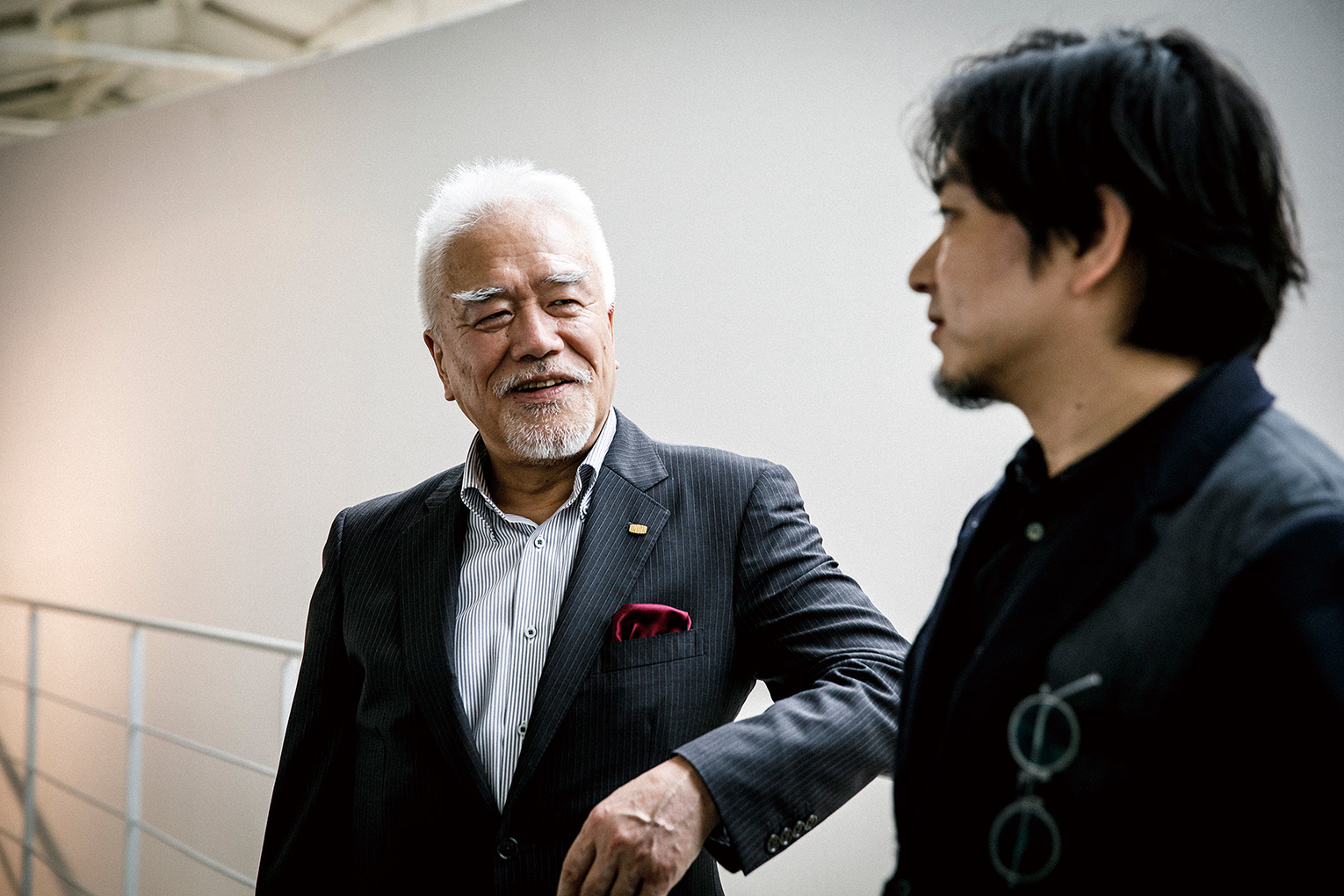
HIRATA
Yeah, architecture is pretty interesting. I really did dream about becoming a biologist. But in the end, I feel like my job as an architect has some unexpected overlap with biology. That's why I think it was for the best that I became an architect.
TATENO
I can really see that life in your works.
HIRATA
I didn't feel it at first, but I do now. I think I've always been drawn to create spaces that evoke the natural sweep of fields and mountains in my work as an architect.
TATENO
So, rather than trying to make buildings that use nature to stand out, you try to create ones that melt in to the natural environment?
HIRATA
Buildings need to have their own identity. If you look at plants, they have such a powerful will to live and to grow. Buildings do have to harmonize with their surroundings, but not just to blend in. They need some specialness or sense of life.
TATENO
Buildings need to really pop and attract initial attention. The trick is to combine that with an aesthetic that does go well with the surroundings when seen years down the line, right?
HIRATA
Yes. The Ota Municipal Art Museum and Library I built recently in Gunma is a perfect example of that. It's right in front of the station, in a kind of run-down part of town. When I first visited, almost nobody was out and about, although apparently some 20 years ago it was a vibrant hub. The community and I shared a desire to return the area to its former glory, so I felt that a piece of architecture that blended in too well would lose that "Wow!" factor people were looking for. Some kind of dynamic change was necessary. So I did the whole thing in pure white. It was important to me to create something surprising and new. Hopefully, after some time passes, it will start to blend in as the area around it redevelops.
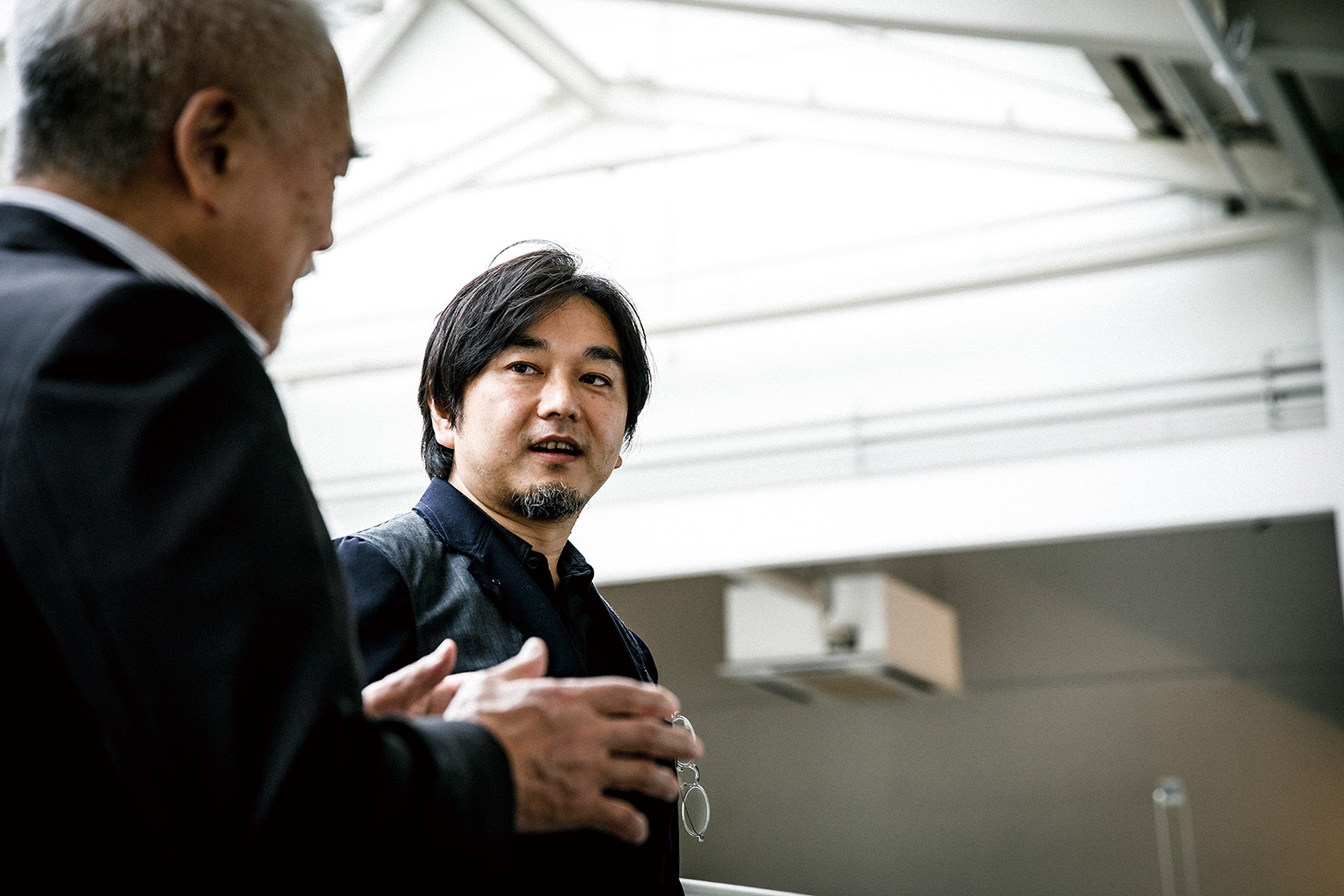
TATENO
Urban renewal is powerful. If you can build something while squarely shouldering an awareness of that responsibility, I think there's the possibility for great things to happen, both socially and artistically.
HIRATA
Yeah, it's powerful. At first, there was really nobody around. But after the building went up, it was like all the people who were in hiding came out of the woodwork. I think it might be the beginning of something.
TATENO
Kyoto University has so many wonderful professors. What made you choose to study under Toyo Ito rather than one of them?
HIRATA
I graduated from college in 1995, right at the time of the great Kobe Earthquake and the Aum-Shinrikyo cult killings. That year shocked the rather introverted world of architecture out of a sort of complacent daze. All of a sudden, fashions were changing. I started to feel that the popular designs I was seeing in magazines of the day were going to disappear. At that time, there was a design competition for Sendai's Mediatheque, and Ito-san's entry ended up winning. When I saw his design, right away I felt "This is it. Here's the next big style. This is revolutionary!" Even on the global stage, this is something special." And best of all, this amazing architect was right here in Japan. At the time, I didn't really know anything about Toyo Ito. But I started going back and looking over his history and his writings, and I began to notice how exceptional his ideas were. So I knew I absolutely had to go find him and try to study under him. Even if I had to go bang on his door, I wanted to learn by any means necessary how to create such incredible ideas.
TATENO
That makes a lot of sense. Ito-san has the spark of originality, which you expanded on and took in your own direction. Is there anything that drew you together?
HIRATA
Yeah. But when he first took me on, I'm afraid I was a completely useless employee. *Laughs.* I really couldn't do anything! It took me three years to get to the point where I could make interesting suggestions to Ito-san. But from then on, it was an incredible job.
TATENO
You two built the TOD'S building in Omotesando at about that time, right?
HIRATA
Yes. I came to him with a proposal that became TOD'S. My original idea was for a building focused on the images made by shadows in the sun. He was able to tie that in with a structure that combined glass and concrete. Omotesando had a lot of buildings with glass facades all lined in a row. So he thought it might be interesting to break up the space by incorporating concrete as well as glass. And with those ideas as our beginning, we started brainstorming the best ways to marry glass and concrete to get the effect we wanted.
TATENO
Speaking of building materials. There's something special about using customized materials like you do, instead of always relying on ready-mades. We craftsmen and manufacturers are always grateful, because designing buildings like that tests our skills and gives us the opportunity to challenge ourselves.
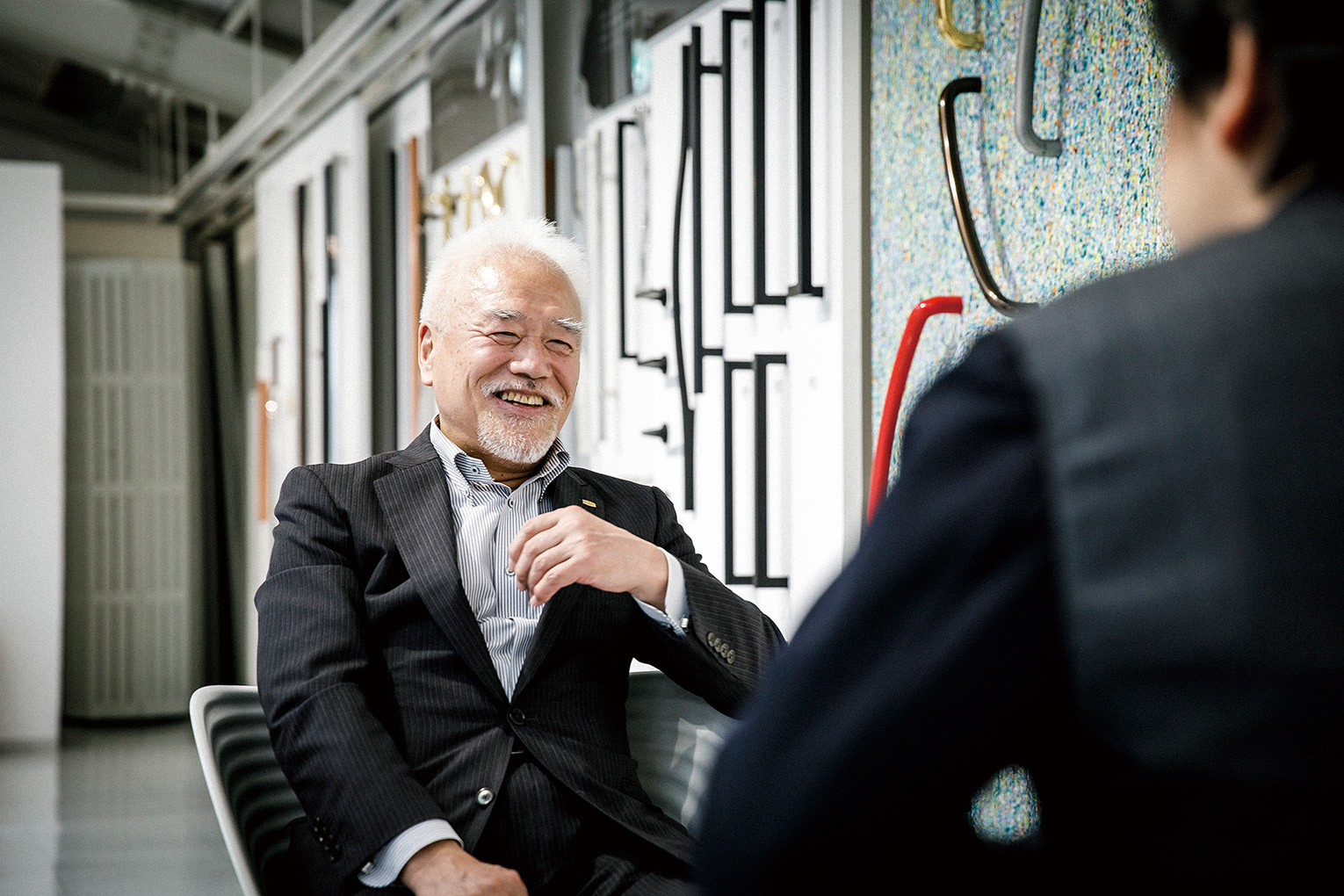
HIRATA
I guess the TOD'S building is the kind of thing you could only have done back then. Nowadays it would be at least three times as expensive! *Laughs.* But even regular buildings now cost as much per square meter as TOD'S did, so perhaps people feel like customization is an unnecessary luxury.
TATENO
Absolutely. Now, when people say "custom-made materials" or "custom furnishings," they limit themselves to changing the size or maybe the orientation. Designers used to make special door handles to fit particular architects and projects. But now almost everyone buys the same mass-produced items, which is a shame. I think it would be great if people took more advantage of the options that are out there.
HIRATA
And yet, sometimes I think our options for ready-made furnishings are almost too good. Choosing between them can be an art and a challenge in and of itself. But yeah, it's always really fun when I get to design and customize the little details of a space.
TATENO
There are so many things to take into consideration, what with the facade and the interior, that in a sense I can understand the reliance on ready-mades. But I think it's great when architects and designers go above and beyond to make sure every detail is perfect. We are always looking for opportunities to progress our skills and technology. But when there's little demand for the exceptional, when nobody asks for the impossible, we manufacturers have no reason to progress. If we as a community just plod along satisfied with what we have now, I'm afraid our technical skills and innovation will start to slip.
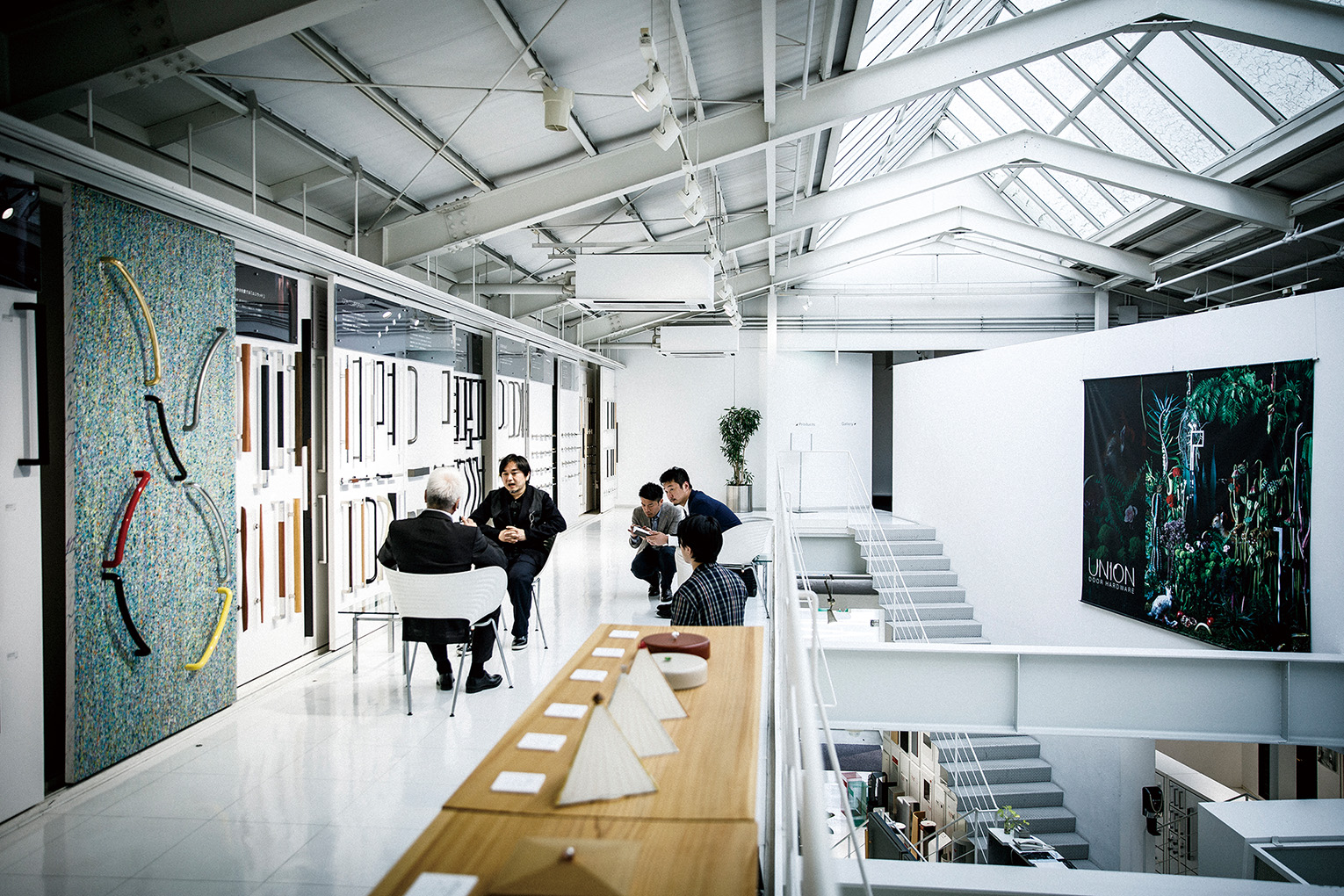
HIRATA
Of course. That reminds me of my recent library and art museum project in Ota. Originally, that town made Nakajima airplanes. Now it's famous for Subaru. The town has several small-to-medium sized manufacturing factories that got together to form a group called AI Lab. We collaborated with them to make furniture for the project, and sent some of our staff to their factories to help put it together. As the factories don’t typically make furniture from scratch, the process mostly consisted of combining set techniques and materials to create specific pieces of furniture. It was amazing how fun it was after getting involved. Of course, there were times where we had to make things using prescribed patterns or methods. But what was really exciting and fun was thinking something up from scratch and making it real. Nothing compares to that feeling!
TATENO
For example, the great architect Togo Murano wanted new custom-built door handles for just about every single building. He repeatedly asked the impossible, but again and again he pushed us to reevaluate our limits and elevate our technique. I think that kind of man is a rarity nowadays.
HIRATA
If I ordered a custom door handle today, would you be able to start making something right away?
TATENO
We would! We could get a sample design 3D-printed for you by the following day. Something really big might be a little tricky to do that quickly, but making a small version so you can get a feel for it would be easy. You could pick the color and everything. If you're interested, by all means come by and try it out anytime!
HIRATA
Wow! Actually, I'm quite interested. I'll give it a try sometime.
TATENO
I want to popularize a new way of doing business. Right now, clients talk to most manufacturers and are automatically presented with a lineup of predesigned mass-produced items. Instead, I'd like to popularize a model where manufacturers carefully listen to our clients' needs and desires, and then custom build something exceptional that's a perfect fit. Custom work elevates the craftsmanship of manufacturers of all kinds.
HIRATA
That's pretty interesting. While he was alive, the photographer Yukio Futagawa used to say that today's architects don't think about individual parts and materials, and that's the problem with modern architecture. He believed that even details like window sashes were critical. At the time, I felt like that's because we're never given the chance to design things like that, but since then I've really started to feel the weight of his words. Maybe he was right all along.
TATENO
Maybe he was. I remember the first time I went to New York, I was entranced by the sweep of the metal buildings. Then, afterwards, when I looked at the basic metal hardware we use - ball bearings, hinges, rivets and screws - I was struck with how American they are. Of course, they're so common now in Japan and across the world that you never really think of them as having a particular style, but the implements we use now were almost all originally made in America.
HIRATA
When I looked at Gropius's Bauhaus buildings, all of their fixtures and fittings were still totally operational. Hearing that they were all originals from his era just blew me away. The details of his structures are just unbelievable.
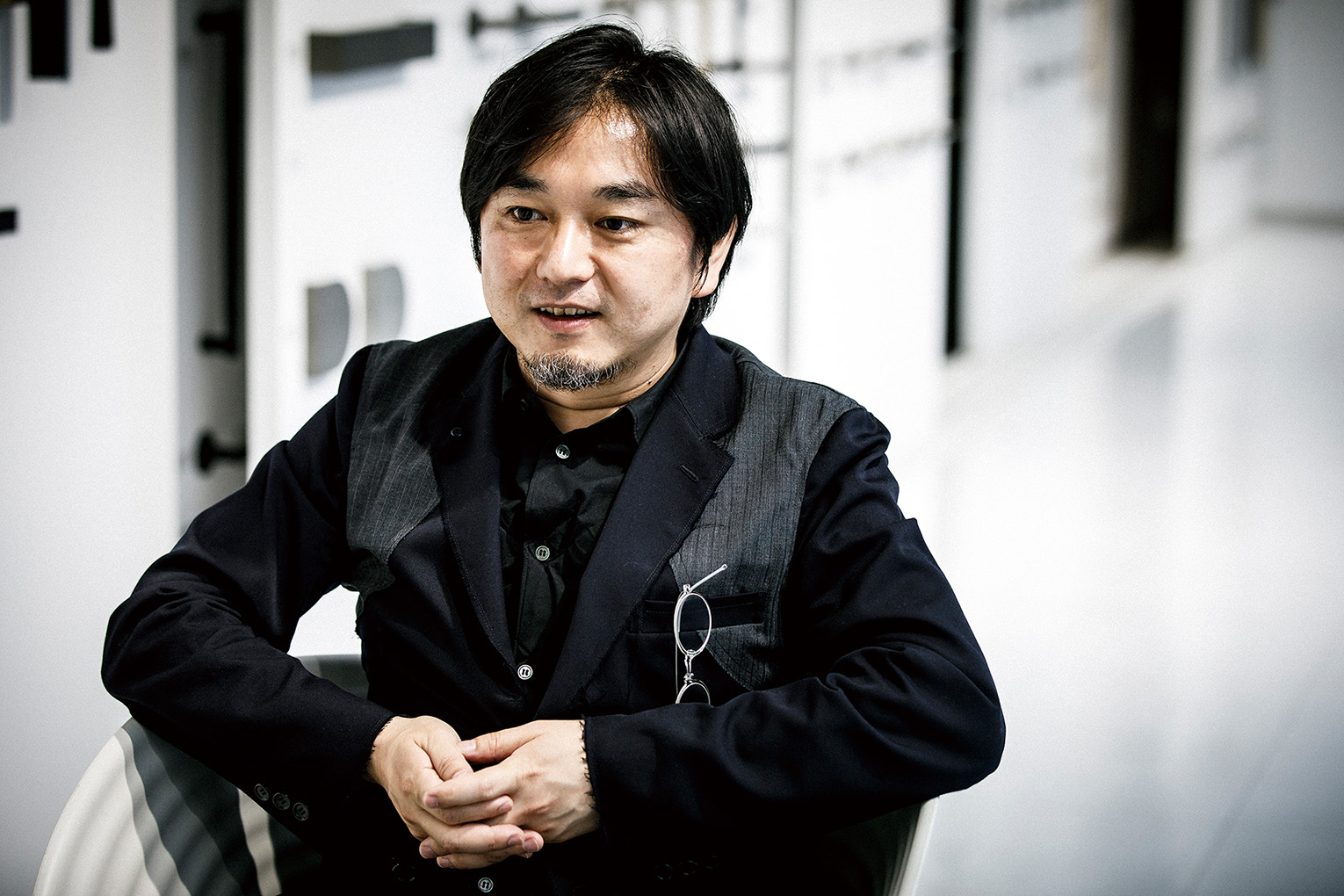
TATENO
Europe is also a bit like this, but Japan has a wonderful tradition of metal hardware. When you take them in your hand, you really get a sense of craftsmanship. For me personally, it's important to approach design as a process of making things that want to last, and to be remembered. At least, that's what we're working to do. I think this kind of dialog is important. Otherwise, we're just going to end up with boring buildings. Not that there's anything wrong with ready-made goods from a business perspective; they sure don't hurt our wallets! *Laughs.* But from the perspective of craftsmanship and artistry, to improve the work we do, I think custom work is vital.
HIRATA
You're right. It sure is fun to make things.
TATENO
Exactly!
TATENO
So, is it easier to be an architect in Japan or overseas?
HIRATA
In the West, you can't get caught up in the details. You also have to be able to know when to move on from something and let it be. You've got to be dramatic, and to be bold. If you focus too much on the interior, your project isn't going to go anywhere: the test of an architect is how well he can make big decisions, impress people, and figure out what to prioritize. On the other hand, although some people think Japanese craftsmanship has declined, there are still a lot of people who care deeply about details. Of course, some will say "don't focus too much on the details," but there's a deep appreciation of thoughtful design. In the end, craftsmen will make what you requested really well for you. That's something really special about Japan: the attention to detail.
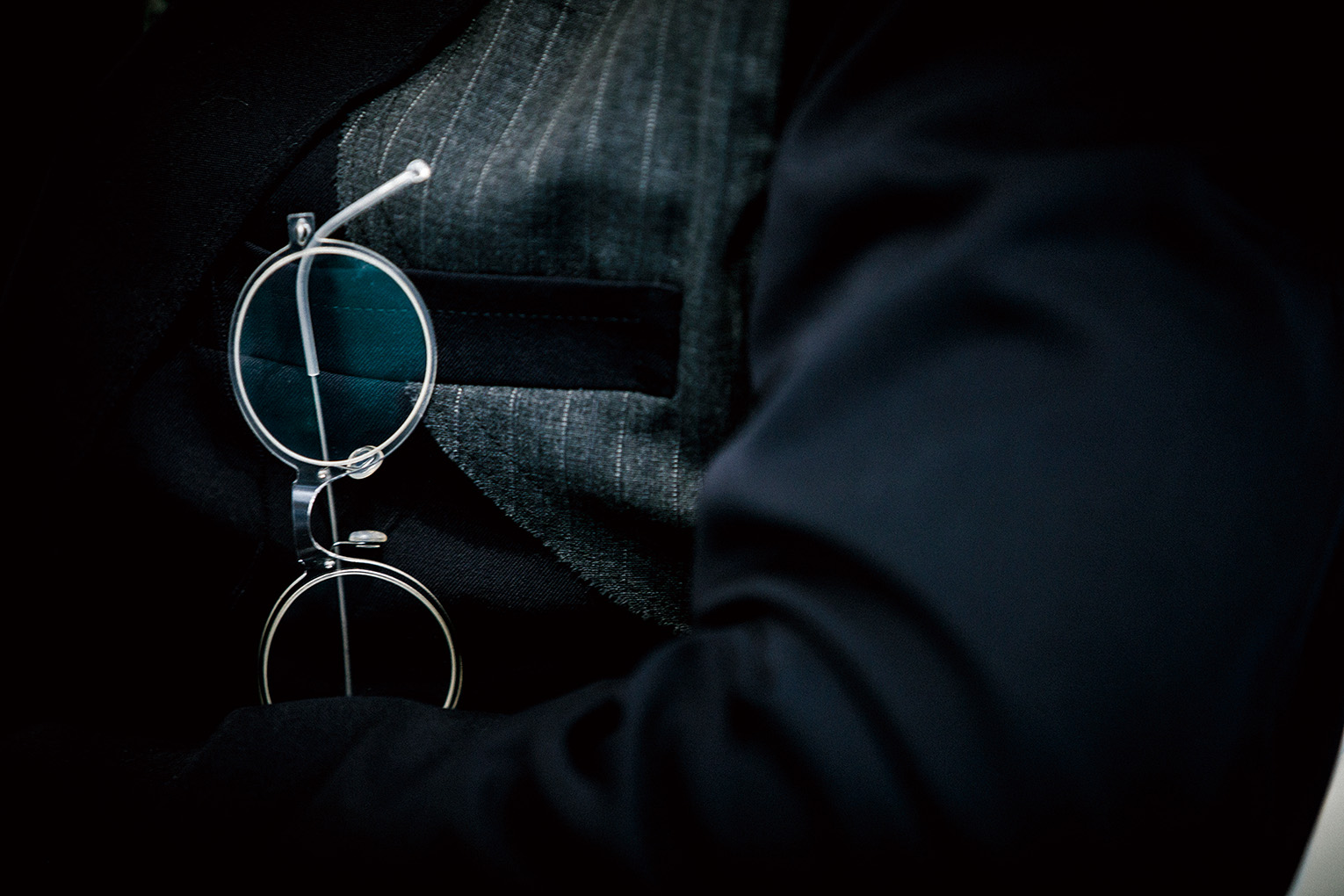
TATENO
So although "design" itself is an English concept, I get the sense that Japan more embodies the designer's tendency to strive for perfection in details. Would you say that's right?
HIRATA
Well, I can't say for sure. When I was working on Papillion in Europe, I felt like the Italian craftsmen were even more skilled and dedicated than their Japanese counterparts. Everyone had his or her own area of expertise and such amazing skill, and they handled incredibly delicate and technically involved jobs so lightly with an expert touch. It made me want to try making something together with European craftsmen. I think I'd like to involve as many different craftsmen as possible. In Belgium, when I was working with Toyo Ito & Associates, I had the sense that something was different about their craftsmanship. So I've been thinking about trying to do some more work over there.
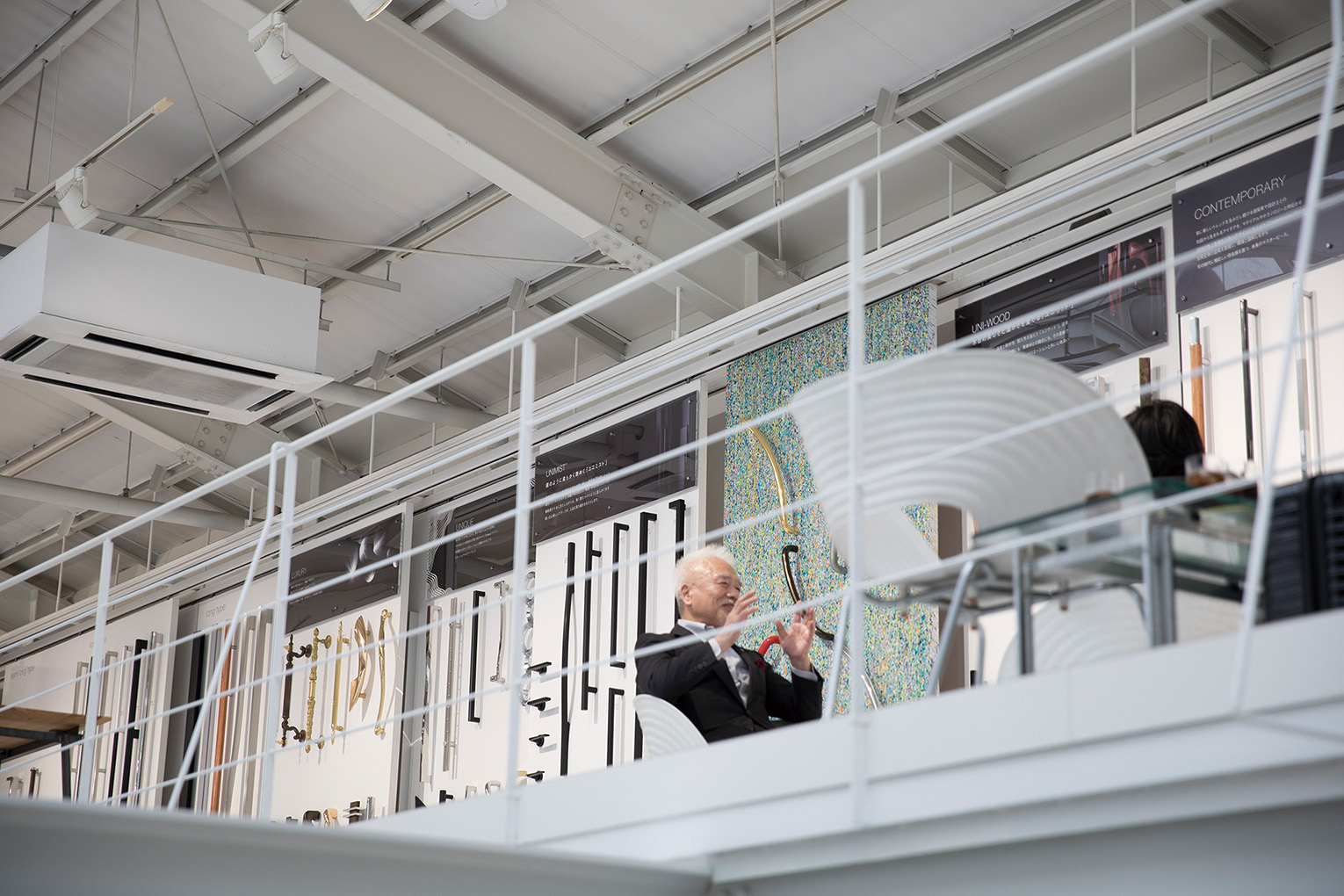
TATENO
That's interesting. I think Japanese craftsmen are getting old. There just aren't a lot of young artisans. The problems of legacy and inheritance are starting to become a real concern. I've always felt the importance of relationships: client relationships, and then beneath that... Some things never change. Young people work for money and for fame: they go into careers where they'll be respected. This is really becoming an urgent problem in Japan. We're bleeding out our technical skills, and our craftsmanship is declining year by year. In Europe, craftsmen are really respected and treated well, but in Japan it's different. People talk about legacy craftsmanship and valued traditions, but when it comes to actually putting up a building, the craftspeople are treated as nothing more than subordinates. There are a few master craftsmen who are respected, but even carpenters, for example, are just considered hired help. And if this keeps going, at this rate not enough young people are going to enter the trades and become craftsmen. Even the artisans who make door handles are all getting old. What's going to happen? Osaka used to be the home of brass casting, but those jobs all disappeared and you could only find them out in the countryside. Now they're gone even in the countryside, and you can only find brass casters in China. It's a really serious problem.
HIRATA
That's too bad. I'd be interested in trying some brass handles though.
TATENO
There are really no factories left in Japan. Nowhere to get a brass door handle. It's amazing but true. And it's beautiful how their color changes over the years.
HIRATA
I'd love to see it.
Actually, I'd love to tour a whole door handle factory.
TATENO
I'd love to bring you around our factory and show you how different things get made.
HIRATA
You know, it would be great if university students could get to see stuff like that.
TATENO
I definitely agree. That would be fantastic, if students could come look around a factory and maybe try out making something. Then, if they could leave having learned something important, I'd be really happy.
HIRATA
When I worked with Toyo Ito & Associates, at one point I was in charge of a project where we tried making houses out of aluminum. I studied the properties of the metal in some depth, went to aluminum factories, explored all the alloys we could make, and tried to get a sense of the modern state of the industry. Ever since, I've had almost a love affair with aluminum. For me, it's aluminum, but in general I think students should have a chance to fall in love with something, whatever it may be. And of course, it would be good to acquaint them with how things get made. Personally, I've never really been to factories in Japan, so I'm quite interested.
TATENO
Isn't metal casting wonderful? It was cast aluminum, right?
HIRATA
Nope. We had a whole aluminum association, mainly focused on making special kinds of aluminum through extrusion processes.
TATENO
You don't see them much now, but 25 years ago there used to be aluminum outer walls everywhere. But of course, they cost too much, so things are different now.
TATENO
I think architecture is quite interesting, you know.
HIRATA
Architecture is the source of buildings. You'd think now would be a terribly grim time for architects in a place like Japan. As the population falls, fewer and fewer buildings are needed. But, on the other hand, I think it can be a good thing for architecture as a field. We have to make sure that the few buildings we do build are done really well.
TATENO
Yes. Take for example Hiroshi Hara's Kuchu Teien Observatory at the Umeda Sky Building in Osaka. More than 200,000 people visit here every year. The existence of a building is a big deal. It's important to feel that specialness. A building is never just a building; it needs to overflow with design and aesthetics so that more and more people want to come visit. Even as our population falls, I want to see spaces that draw tourists and visitors for decades and decades.
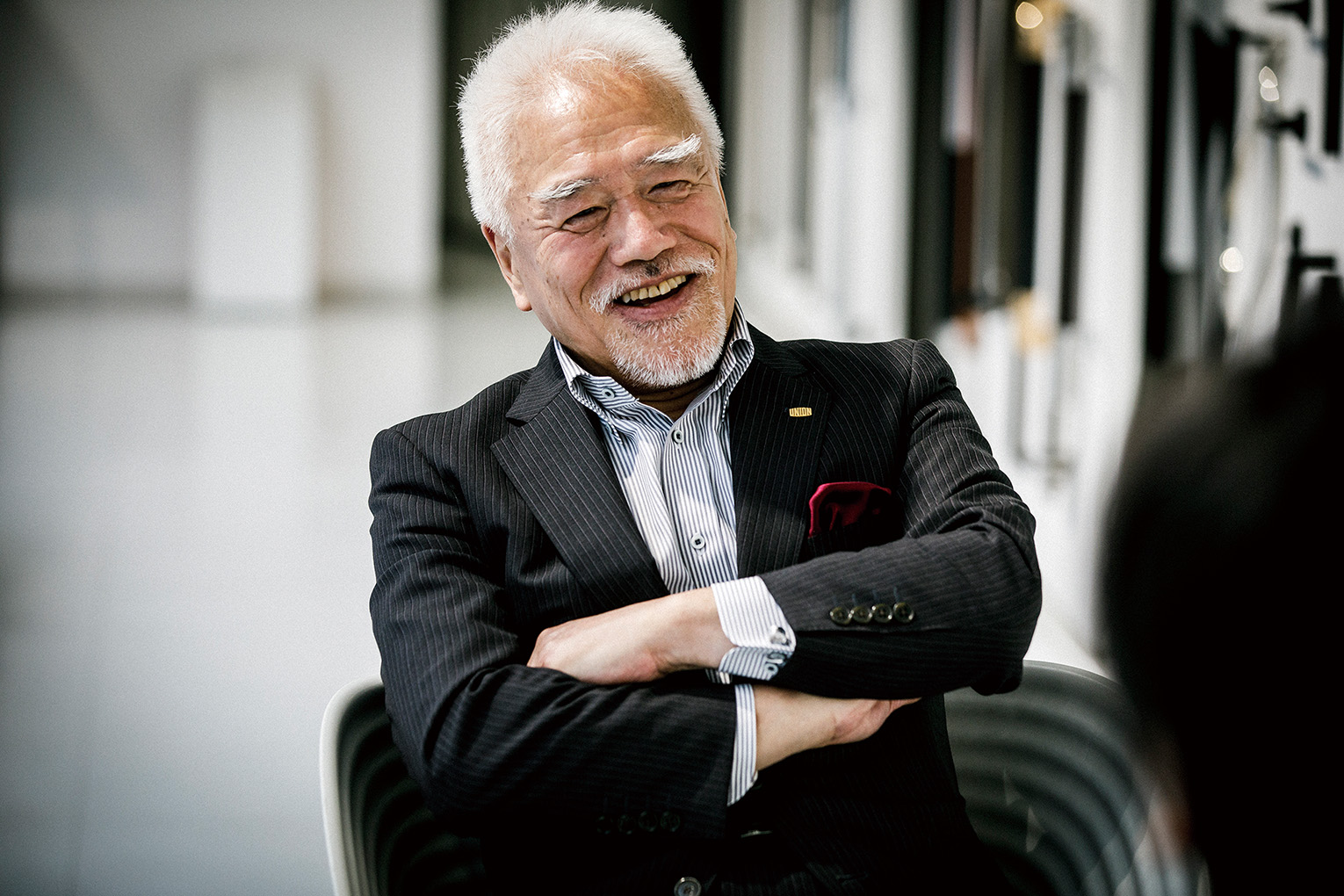
HIRATA
I see. This may be true in Japan as well, but in Europe there are cities famous for their architecture that only got that way because all the people living there strived to make each building as well as they possibly could, each and every time. They put in so much effort. Through various challenges across the years, they've been beautifully developed from era to era, until you get wonders like modern-day Paris. I'd love for Japan's cities to join them.
TATENO
Definitely. Unless each town creates something special, everywhere you go will look the same.
HIRATA
I think people are gradually starting to realize that it's not good for everything to look the same. And I think that's a great thing!
TATENO
You mean young people today think like that?
HIRATA
I think so. But they don't have the money. *Laughs.* That's a problem.
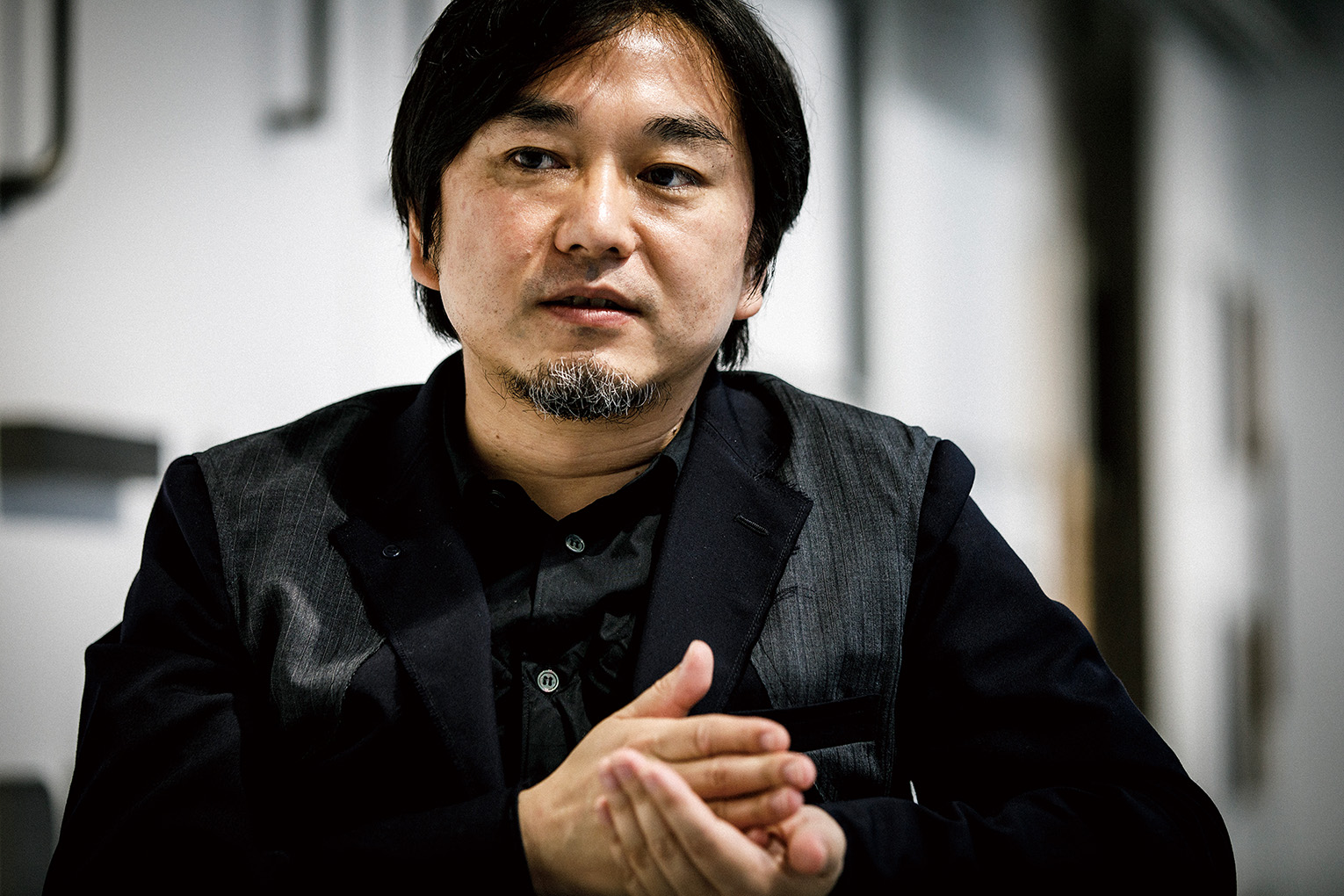
TATENO
Hahaha! Of course, there's our chance! Back in the old days, Japanese companies didn't just want to make a profit, they wanted to make good things. Just look at the State Guest House, Akasaka Palace. It's incredible. With the current generation of young people, there's a chance to revive that way of thinking.
HIRATA
I would love it if Japanese politicians and the government valued Japanese architecture a bit more.
TATENO
Yeah. In Osaka, there's a historical architecture viewing association. People get together and go see unique historic buildings. They even have posters advertising the group in the subway. It's a really fun concept, and I wish we could see more ideas like that.
HIRATA
It would be great if the people constructing the buildings could work with that mindset, right?
TATENO
When we do restoration work on historic buildings, I always try to not simply restore the past, because things always change over time. Instead, we try to stay as faithful as possible to the original but put in some new twist, so that the restoration itself becomes a part of history.
HIRATA
Yeah. I'd love to help design that kind of work!
TATENO
Let's do it!
HIRATA
Every project has problems and limitations. There are always requirements, like staying true to history. But necessity can be the mother of invention and can lead to beautifully creative work. At the end of the day, it all comes down to whether or not the people making the building approach it with a sense of love.
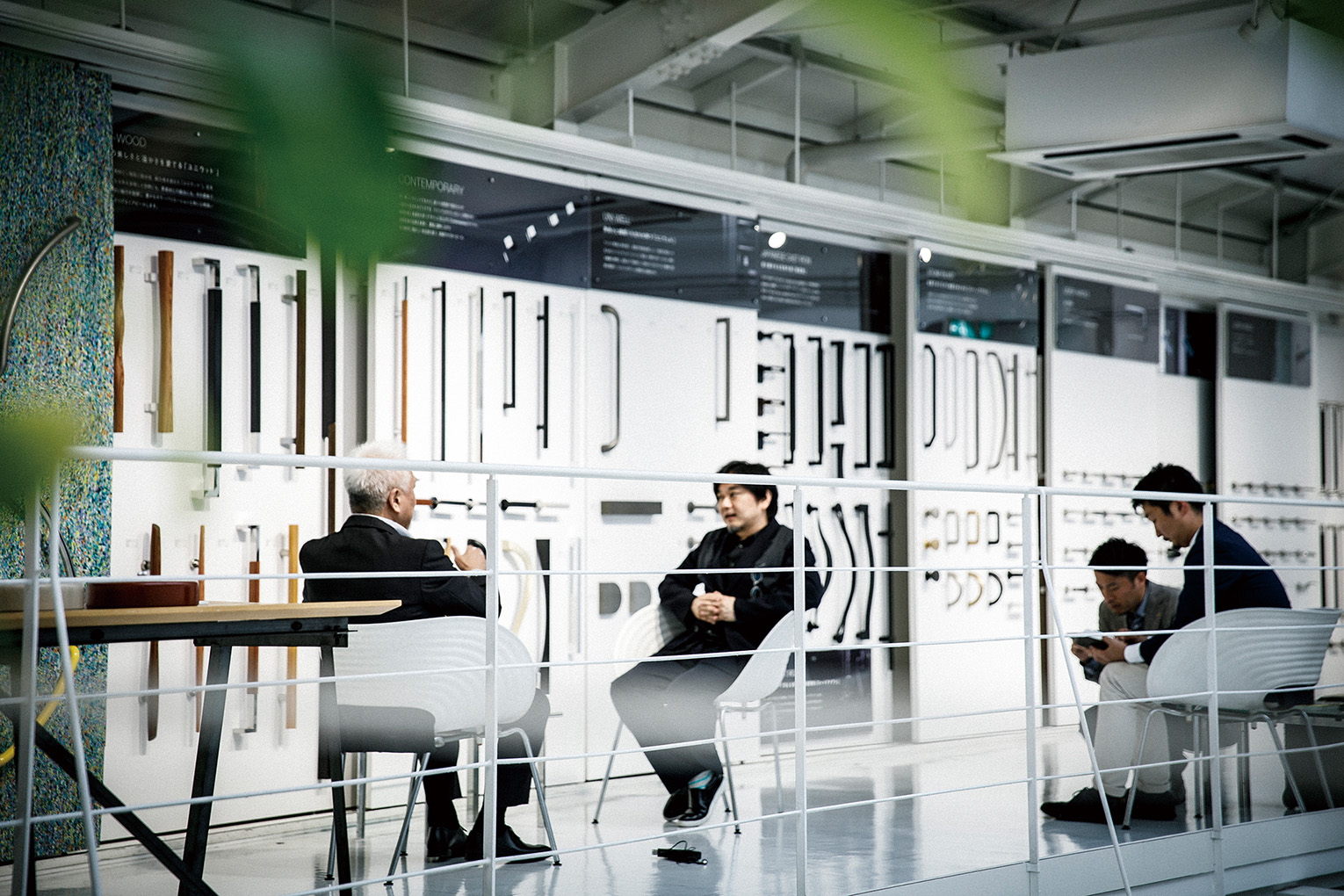
TATENO
Architecture demands that passion and energy, right? I'm sure it varies somewhat project to project, but how long do you spend focusing on your designs? I'm sure it takes an enormous amount of concentration and energy.
HIRATA
It does. Our project in Gunma took three years all together, but I spent a half a year just on the preliminary design. During that time, I met over and over again with citizens' groups and other local stakeholders to decide on elements of the design. Incorporating their ideas into our plan, we must have made well over two-hundred different drawings in all.
TATENO
Wow! That's incredible.
HIRATA
Yeah, every day we brought people in to talk in our office. I had to do everything I could just to stay afloat with all the meetings. But in the end, it was interesting, and I had a lot of fun. You start to see perspectives you've never encountered before. Sometimes our discussions would get pretty heated, but those were the times I really felt like we were grappling with issues that mattered. When we brainstorm on our own, groupthink starts to set in and we get complacent. You can adopt a method of going with whatever you find is cool, but if you involve others in the process, it forces you to work within a certain framework, and this really helps to get things done with remarkable momentum. I think that kind of community involvement or even entanglement is going to be more and more necessary in the future. The design process has to be transparent and open to input from all sorts of people. In that way, we're going to discover entirely new kinds of structures and designs. Although I expect architects will still be involved, I expect the process to move towards more and more input from a broader range of people until eventually it's an endeavor shared by entire towns and cities. Working together and combining our forces, we'll make buildings beyond what we can even dream of today.
TATENO
I think you're on to something there. I wouldn't be surprised to see the concept of entanglement or tangling, which you've pioneered, become a trend. To change the topic a little, you're interested in building off of the public and personal relationships between people. I'm interested in the relationships between interior and exterior design, as representative of the private versus shared spheres of life. My company makes door handles, which mark the liminal connection between these two aesthetic and spatial realms. I'm sure as an architect you have a feel for this as well. I'd love to hear your thoughts on the roles of doorways and walls as the dividers and connectors of space.
HIRATA
Hmm. I'm moving away from walls as stable, sturdy dividers. Instead, I'd rather break up space with amorphous walls that are almost jelly-like, flowing and pushing into the surrounding space. To me, this embodies the concept of entanglement, like you said. Nevertheless, I don't think walls will entirely go away. To put it simply, and this probably goes for doors as well as walls, I like door handles that are simple and beautiful objects. Before any consideration of their role as functional items, they have a certain definite shape and existence in their own right. As aesthetic objects, they can be seen from a variety of angles, changing with each viewing. So, considered as art pieces, they are many-layered and quite complex. My concept of "entanglement" doesn't just mean the relationships between people; it's also about the integration of objects and materials into a design holism that's more than the sum of its parts. As you know, there's a kind of kelp that's commonly eaten in Japan called kombu. But in the depths of the sea, you can find kombu with fish eggs laid all along it, all tangled with neighboring strands, a delicacy in its own right called komochi-kombu. And this kind of entanglement is defined by the integration of multiple layers: eggs with kelp, kelp with neighboring strands, all permeated by the salt of the sea. Doors and walls don't exist on their own, but in conjunction with one another. Handles form another piece of that entanglement, which grows exponentially in complexity. If you stare at these things for long enough, the entanglement starts to unravel, or perhaps envelops you, and instead of seeing discrete objects you reduce things to aggregations of raw materials: planes of wood, lumps of metal, sheets of glass. As an architect, I feel very deeply about the role played by the aesthetics of component parts, including door handles. I'm now coming to believe in not the elimination of walls and doors, but rather their synthetic integration as an interface with external space.
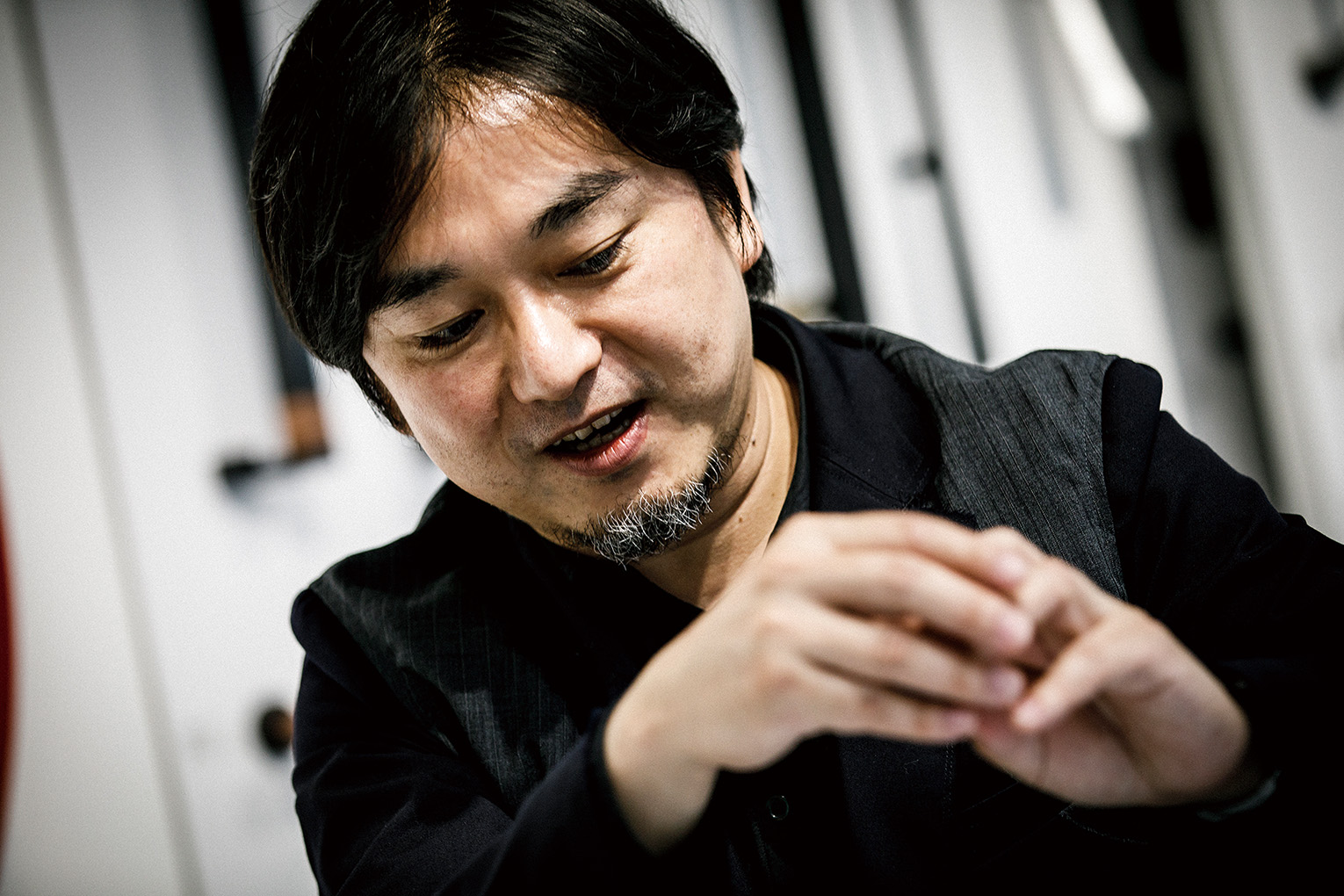
TATENO
Do you feel your academic theories influence your practical designs as an architect?
HIRATA
Well, eventually when enough of your mentors retire, it's your turn to teach. *Laughs.* Of course, I owe a great debt to the professors who taught me, and realize it's my responsibility to pass on what I can to the next generation of students. But I don't want to limit myself to teaching university students. Usually, I try to lead by example: creating things for students to see. I don't have any particular aspirations to revolutionize the erudite field of academic architecture. But one way or another, I'm at a university, so I want to work on the kinds of projects that can only be done there. Experimental projects that don't make any money. Buildings that clearly express the fundamentals of architecture. Projects that maybe give a vision of the future. As an academic I think I do pretty similar things as I would in a regular architecture office, overall. Getting students to think about things like entanglement is really fun for me. But teaching is hard!
TATENO
I bet! *Laughs.* Mentors can have huge impacts on how a student turns out. They have the ability to inspire. Students have a long journey, from job hunting to climbing the career ladder from firm to firm, until eventually they become independent architects. I know you went down that road. Being able to support and influence people at the very beginning is a powerful thing. I bet you can get students to read not just architecture books, but also about biology, etc. Right?
HIRATA
Yeah, I try to get people to read. Every time I lecture, I talk about what books relate to the material at hand and make a suggested reading list. And almost nobody ever reads it. *Laughs.*
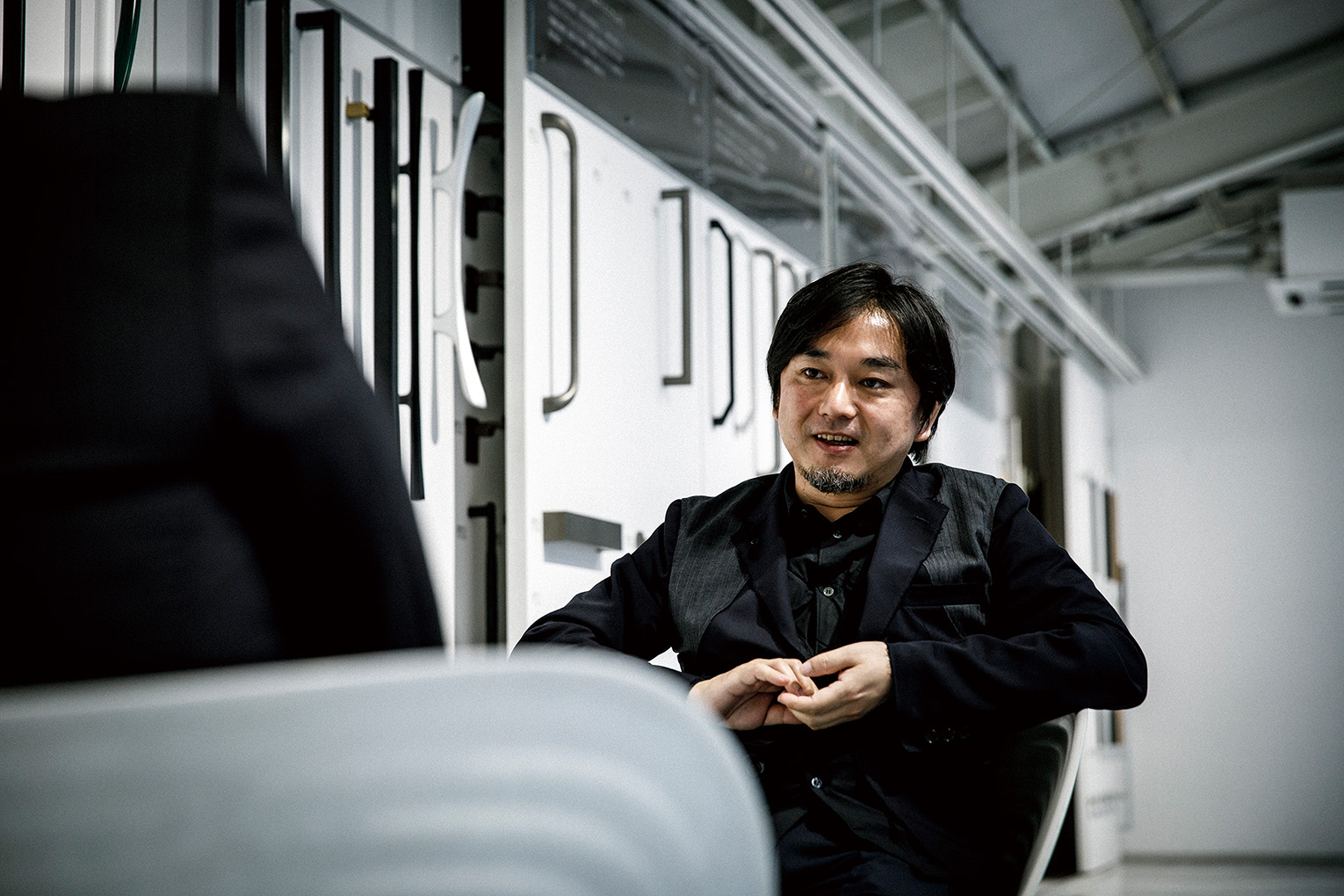
TATENO
*Laughs.* Young students nowadays won't read anything. But it's so important. You're not suggesting hard-to-find tomes that they can't find in the library, are you?
HIRATA
No! I always let people know they can go over to the university library and find everything I'm talking about right there! *Laughs.*
TATENO
Great architects usually have fantastic collections of books. They read all kinds of things. Even things you wouldn't think relate to buildings at all, like history books. Architects draw on all kinds of knowledge.
HIRATA
Yeah. Construction is influenced by so many things. Usually, when I get a project from a client, I get totally absorbed in reading about the client, their industry, etc. When I'm entering an architectural competition, I go to the site of the proposed construction. I explore the town, and research it. So as an architect, over time your field of knowledge and expertise really widens. It's one of the joys of the profession.
TATENO
I'm always impressed by how much architects know. Just as with botany, so many different things can be involved that it's important to be widely knowledgeable. For example, I didn't know anything at all about fractals. But your book piqued my interest, and now I'm inspired to learn more.
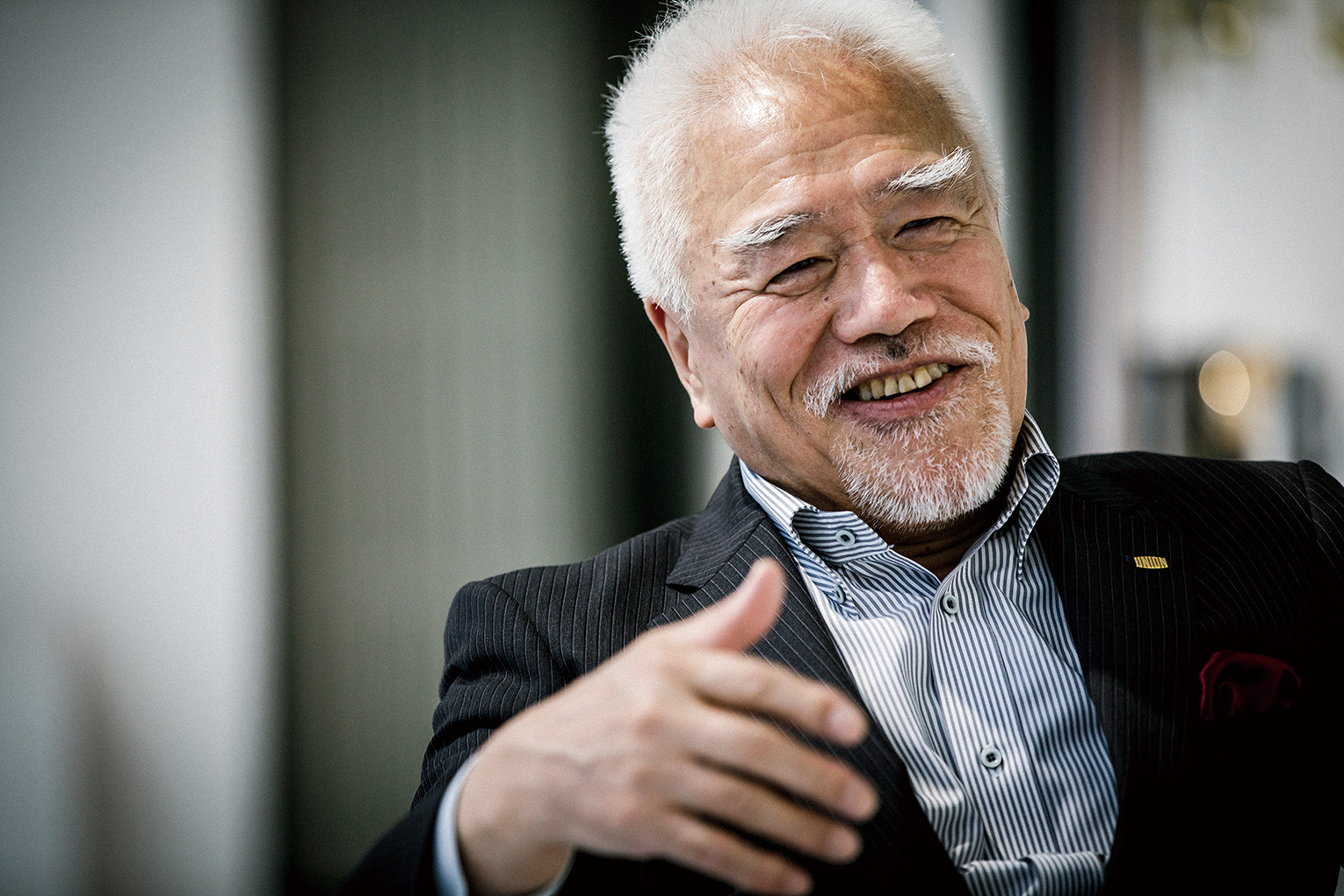
HIRATA
Yeah, they crop up in all kinds of places. I want to try out different ways to pull out the potential hidden within shapes like fractals. But it's important to remember not to focus too much on any one part of the form: it will become prominent or exaggerated while the rest remains unremarkable. But on a different subject, I find it fascinating to see how people all over the world build things in different ways. You can only get so far doing armchair academia, so I'm thinking about ways to bring together diverse groups of people and diverse perspectives. For example, using big data, we can map where flu outbreaks are going to happen even without knowing why. If you can get enough input data, powerful computers can come to all sorts of analytic insights. Right now I'm pondering this kind of statistical, computational approach to architecture as a way to move beyond geometric forms and find or rediscover new ways to build.
TATENO
I was recently speaking with another architect who told me that students have no creativity, nor any drive to seek out or remember knowledge and information. You deal directly with students; what do you think of their ability to come up with new ideas? Of course, the educational system here in Japan is totally different from that of Europe or America. Even at the top school in Japan, Tokyo University, it's all about mastering a certain number of content items: filling in blanks. But there's no emphasis on thinking about things. AI is going to define the future. If architects don't define themselves by their creativity and integrate with broader concepts and trends from outside their discipline, the world of architecture is going to become stale and perhaps outmoded.
HIRATA
What a question! But there are plenty of intelligent, creative people in Japan. When you ask "which is better, Japan or the West," it's in the eye of the beholder, but there are unquestionably many Japanese people doing amazing work. Education problems aside, I think interesting and creative people tend to crop up anyway. By the time they walk in the door of a university, I think their creative potential is more or less fixed. That's why I consider it more important to look at what early-childhood educators and grade-school teachers are doing than anything college professors do or fail to do.
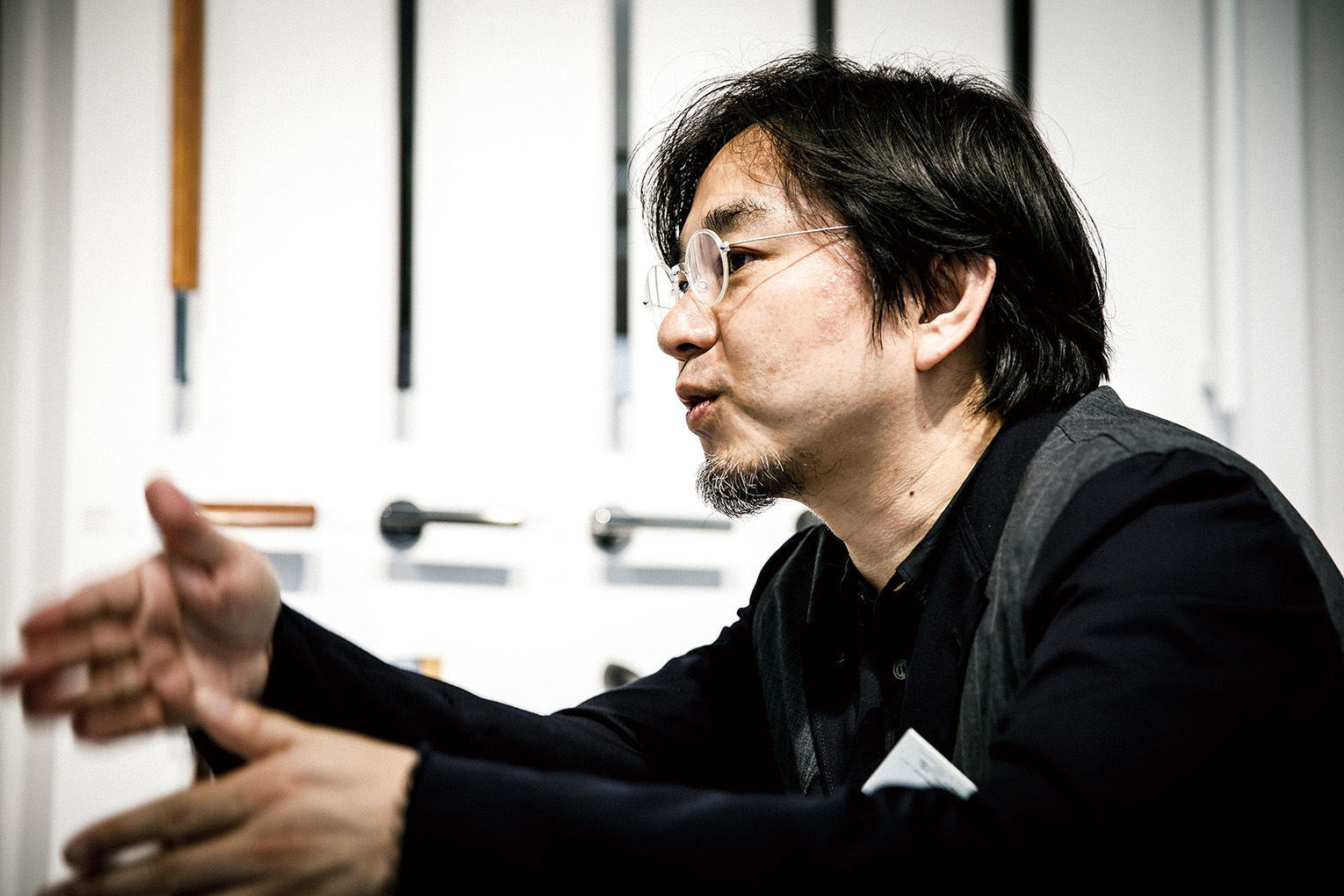
TATENO
I see. Teachers at that age can instill a foundational passion for biology and living things. If they just focus on hammering in the prerequisites to get in to Tokyo University, that passion for biology is never going to spontaneously well up in college. It's important to get kids to look at and think about a wide range of things. And if the next generation of people don't have their creative potential sparked while they're still young, they're all going to be unable to compete with AI. What makes humans unique isn't our ability to master any one thing, but our ability to think about and connect all kinds of things. It's actually pretty amazing. AI is made to master one particular thing, and never looks beyond that.
HIRATA
You know, there's been talk of creative AI lately.
TATENO
Yes, well. If it comes to that, I'm not sure there will be a lot we can do. *Laughs.* Speaking of which, it seems we now have machines with AI that can cook! You just need to put in a recipe and ingredients. Even lawyers are using AI clerks to sort through archives and find references to relevant past cases. According to the report I saw, at this rate over half of the lawyers in America are going to be made unnecessary. Up until now, so many people have specialized to master just one thing. And they're all at risk of losing their jobs. But I really want to believe I'll never see robot architects. I suppose AI would design really boring buildings. There's so many factors, like design aesthetics, that have to come together perfectly.
HIRATA
Yes, but more than anything else, I think it's important to take an interest in something. Your grade school, the town you grow up in, and the people you meet are all vitally important. The story goes that the great self-taught architect Tadao Ando only came to architecture because he lived next to a carpenter. This neighbor let him see how he worked, and he came to love it. I definitely think having opportunities like that is important. We've got to spark passions.
TATENO
Yeah. Like for lizards.
HIRATA
It doesn't have to be anything particularly deep or lasting. Kids just need exposure to interesting things.
TATENO
Golden-ringed dragonflies!
HIRATA
*Laughs.* Thank you for reading up on me. You're right, I love golden-ringed dragonflies more than anything else in the world. But I'm never able to catch them.
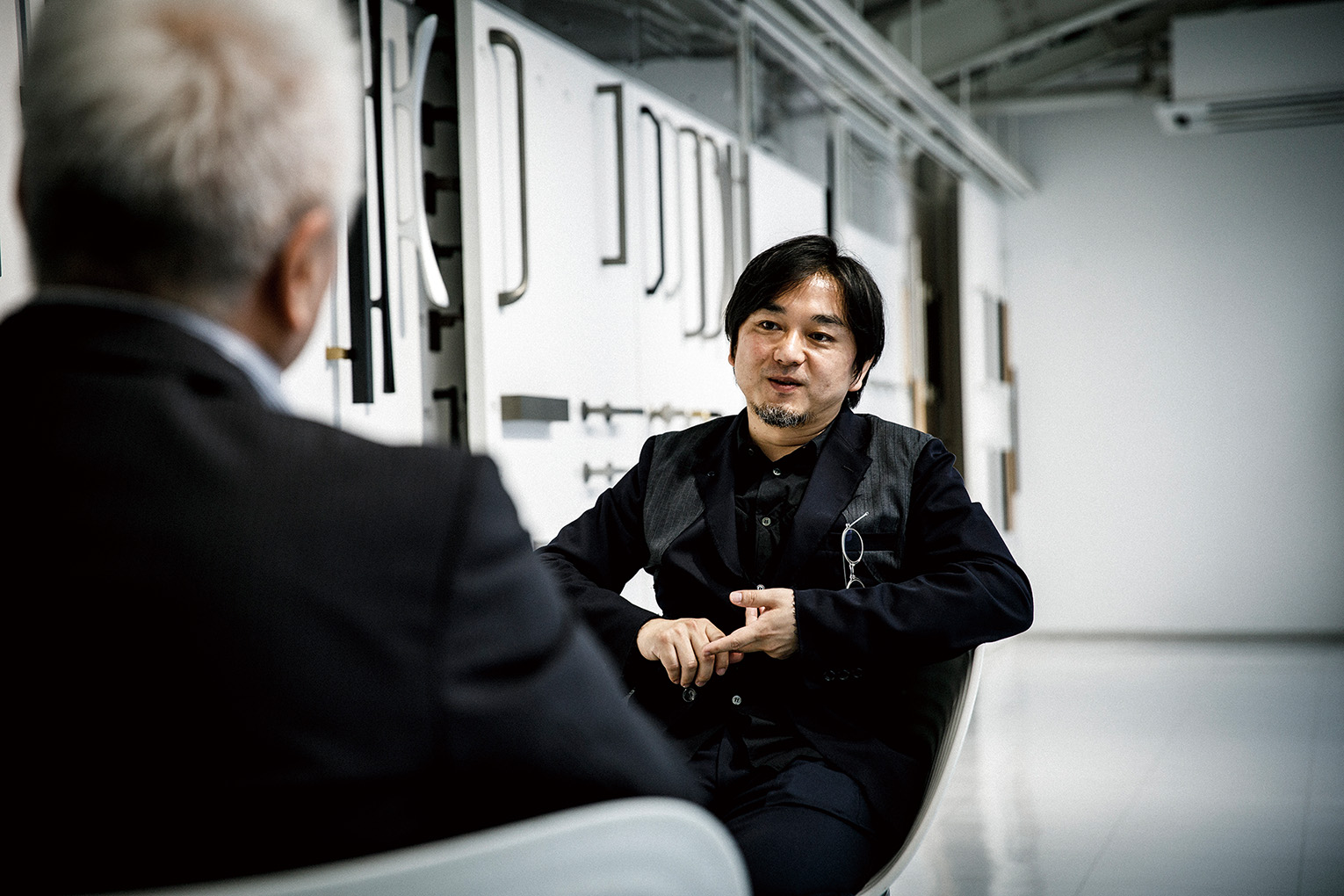
TATENO
When I was young, I think I caught one.
HIRATA
Really? I don't know what it is, but they're inexpressibly wonderful. Even in comparison with other dragonflies.
TATENO
They're really rare, right?
HIRATA
The other day I was out walking and a golden-ringed dragonfly whizzed right past my face, and I was instantly transported back to my childhood. My heart was racing. I didn't try to go catch it or anything, but I was still just as moved by that indescribable beauty. The brilliant emerald color of their eyes is so full of life. When they die, it fades so quickly to brown.
TATENO
There are all sorts of dragonflies, from Lesser Emperor Dragonflies to clubtails. They're all special in their way, but none of them can hold a candle to the golden-ringed dragonfly.
HIRATA
Lesser Emperors are great too, but they just can't compare.
*Interview concludes*
Both
Thank you very much.
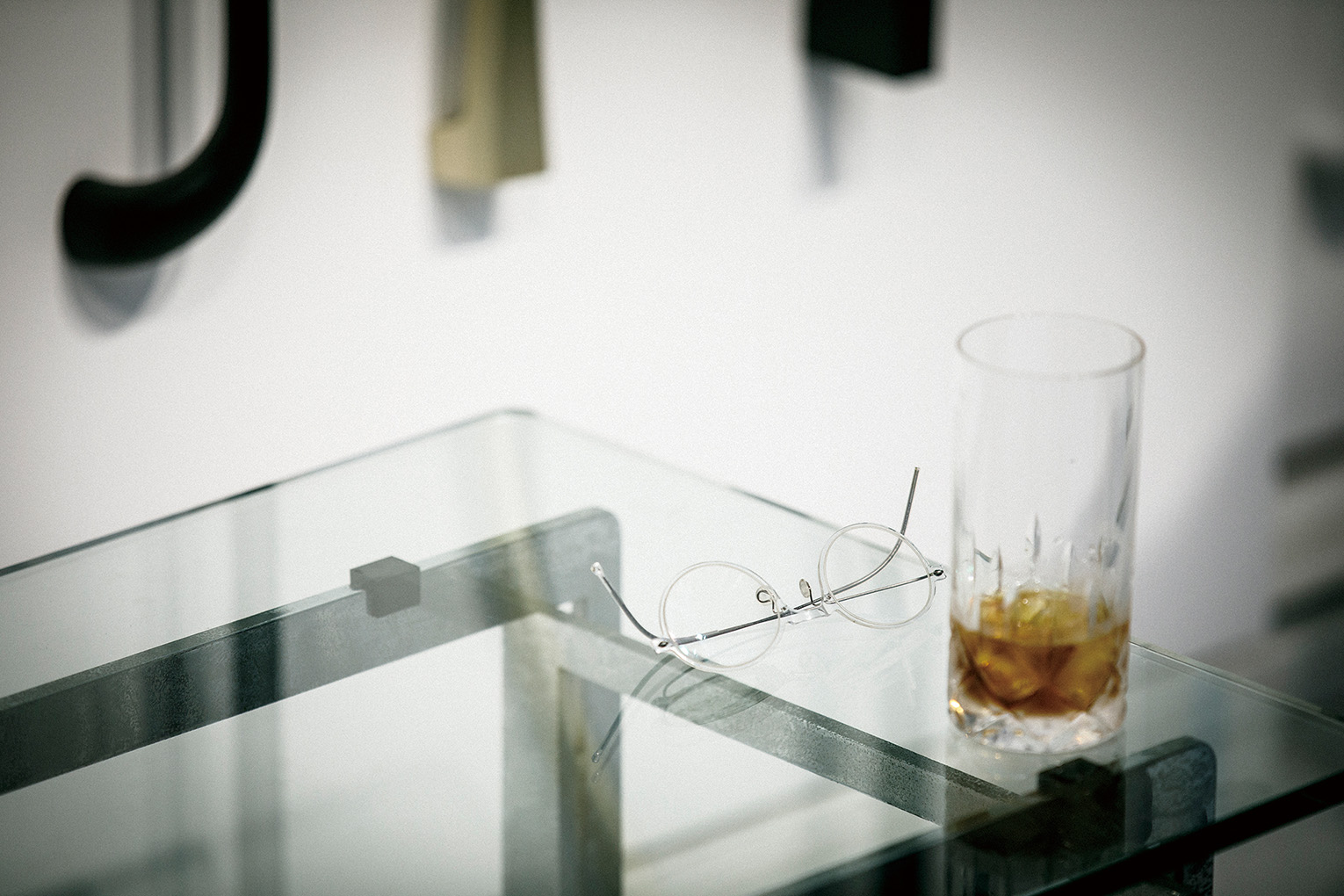
Planning: Naoyuki Miyamoto, Keigo Kuwano
Photography: Norinao Miyanishi
Transcription: Keigo Kuwano